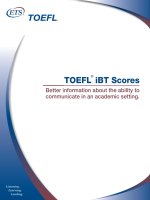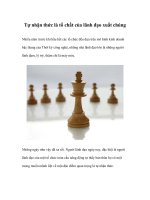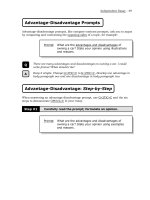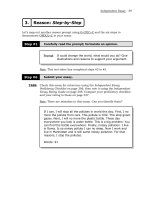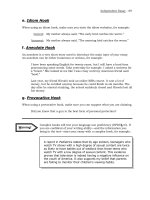Tài liệu Mapping TOEFL® iBT Scores to the CEFR: An Application of Standard ... pdf
Bạn đang xem bản rút gọn của tài liệu. Xem và tải ngay bản đầy đủ của tài liệu tại đây (563.91 KB, 13 trang )
Mapping TOEFL® iBT
Scores to the CEFR:
An Application of Standard-
Setting Methodology
Richard J. Tannenbaum
E. Caroline Wylie
Educational Testing Service
EALTA Conference June 2007
Sitges, Spain
2
Purpose
• Identify scores on TOEFL® iBT corresponding to the six
proficiency levels of the CEFR
– A1 and A2 (Basic)
– B1 and B2 (Independent)
– C1 and C2 (Proficient)
• Focus on candidates with “just enough” language skills to be
classified into each CEFR level
• Classifications by test section
– Writing, Speaking, Listening, Reading
3
Mapping Process
• Expert panel
– 23 language specialists from 16 EU countries
– Familiar with TOEFL®, English language instruction,
learning and assessment, and the CEFR
• Standard setting approaches
– Performance-sample (Profile) approach for Writing and
Speaking
– Modified Angoff approach for Reading and Listening
4
Familiarization/Calibration
• Pre-meeting Assignment – Familiarization with CEFR Levels
– Review selected tables in the CEFR
– Write down key skills of candidates just performing at each
CEFR level
– Done for Writing, Speaking, Listening, Reading
• During Meeting – Calibration to CEFR Levels
– Consensus on skills expected of candidates just performing
at each level
– Pre-meeting assignment, small-group and whole-panel
discussions
5
Sample Level Descriptors
Speaking
• Speaks with some fluency
• Copes with everyday situations
• Briefly gives reasons and
explanations
• Describes and briefly explains
with preparation graphs/tables in
field of interest
• Speaks about familiar abstract
thoughts, feelings
• Maintains one-on-one
conversations, but may need
assistance
• Gives clear detailed descriptions
and prepared presentations
• Develops clear arguments with
relevant examples on wide range
of topics in field of interest
• Sustains conversation with degree
of fluency and spontaneity
• Takes listener and cultural context
into account
• Speaks without causing undue
stress to the listener
B1
B2
6
Profile Approach
• Initial focus on A2, B2, C2 levels
• Review and discuss tasks and rubrics
• Review performance level descriptions (A2, B2, C2)
• Review response profiles across score range
– Writing 11 profiles
• Score points 2, 4, 6, 8, 10
– Speaking 11 profiles
• Score points 6, 10, 14, 15, 18, 19, 22
7
Profile Approach
• What score would a “just qualified” A2, B2, C2 candidate earn?
– Writing: 0 to 10, in half-point increments
– Speaking: 0 to 24 in one-point increments
• Three rounds of judgments, with feedback and discussion
– Mean, median, min., max., standard deviation
– Round 2 includes task-level data mean scores of
candidates in bottom and top quartiles, and overall
– Round 3 includes percentage of candidates classified A2,
B2, C2 based on panel’s recommended cut scores
• Locating the cut scores for A1, B1, C1
8
Modified Angoff Approach
• What is the probability that a “just qualified” A2, B2, C2 candidate
would know the correct answer?
Or
• How many of 100 JQCs would know the correct answer?
• Three rounds of judgments, with feedback and discussion
– Mean, median, min., max., standard deviation
– Round 2 includes task-level data—P+ values of candidates
in bottom and top quartiles, and overall
– Round 3 includes percentage of candidates classified A2,
B2, C2 based on panel’s recommended cut scores
• Locating the cut scores for A1, B1, C1
9
Results
Raw Scores and SEJs
43 ±.3640 ±.5529 ±.8114 ±.68
Reading
45 raw pts
-31±.2226 ±.6417 ±.34
Listening
34 raw pts
-22 ±.1618 ±.3115 ±.1610 ±.306 ±.14
Speaking
24 raw pts
-9 ±.106.5 ±.145 ±.073 ±.24-
Writing
10 raw pts
C2C1B2B1A2A1
10
Results
Scaled Scores
2928228
Reading
30 scaled pts
-262113
Listening
30 scaled pts
-282319138
Speaking
30 scaled pts
-282117 11-
Writing
30 scaled pts
C2C1B2B1A2A1
11
Results
Panelist Evaluations
• All panelists reported that the:
– pre-meeting assignment was useful preparation
– instructions and explanations provided were clear
– training prepared them to complete their standard setting
judgments
– between-round feedback and discussion was helpful
– standard setting process was easy to follow
12
Conclusions
• Successfully mapped TOEFL® iBT scores to B1 through C1
levels for all four language skills
• Listening and Reading judged to be too challenging for threshold
A-level candidates
• Writing judged to be too challenging for A1 threshold candidates
• Explore convergence with other sources of information
Thank You!
An interim report of this study is available at
/>Contact Information

